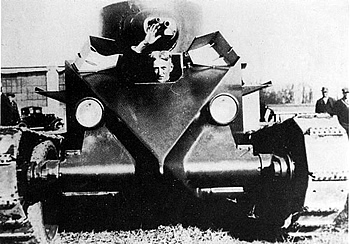
Last updated on February 17th, 2019 at 09:49 pm
The M1931 Christie tank was designed by J. Walter Christie, an American engineer who created some innovative tank designs. Christie invented the Christie suspension system, which allowed tanks to have a low center of gravity and a low silhouette and gave them the ability to move at high speeds.
The Christie suspension system utilized a convertible drive. This means that the tracks could be removed when the tank was traveling along a road, so that the wheels rested directly on the road. This enabled the tank to move faster and reduced the wear and tear on the tracks.

In 1928, Christie presented a tank that he designed, the M1928, to the US army. This tank used his revolutionary suspension. The army rejected the M1928 for a variety of reasons, including the facts that its armor was very thin, it had no turret and there was no way to upgrade its armament.
At the army’s request, Christie created an improved version of the tank, the M1931. This new tank had a turret and a 1.46 inch (37mm) main gun.
Automotive improvements increased the maximum speed of the M1931 Christie to 46 miles per hour (74kph) on its tracks and 70 miles per hour (113 kph) on its wheels.
Mass production of the M1931 never took place; the tank was only built as a prototype.
At the time, the Christie and the US Army had different ideas about the use of tanks in warfare.
Christie thought that tanks should be light and move quickly so that they could easily move past enemy lines and infiltrate enemy territory. The army wanted big tanks with heavy armor and powerful weapons that would stay near the front lines and support the infantry.
However, although Christie’s designs did not encounter much acceptance among the US army, the armies of other countries recognized how effective they could be.
The Poles, the British and the Russians all used the Christie suspension in their tanks.
The Soviet Union bought two M1931s and used them as models for their BT Medium Tank Series.
M1931 Christie |
|
|---|---|
| Active: | 1931 (prototype) |
| Crew: | 2 |
| Weight: | 10.5 tons (10,668kg) |
| Length: | 17ft 10in (5.43m) |
| Height: | 7ft 3in (2.21m) |
| Width: | 7ft 4in (2.24m) |
| Weapons: | Main – 1.46in (37mm) gun, Secondary – 0.3 inch (7.62mm) machinegun |
| Armor | Maximum – 0.63in (16mm) |
| Engine: | Liberty 12-cylinder gasoline, 338hp |
| Speed: | 46 mph (74 kph) on tracks, 70 mph (113 kph) on wheels |
| Range: | 175 miles (274 km) |
